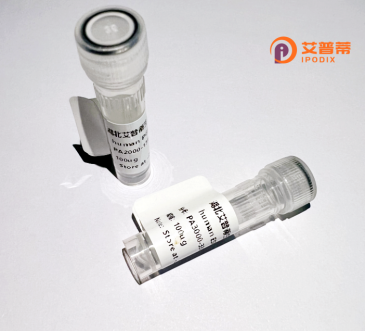
| 纯度 | >90%SDS-PAGE. |
| 种属 | Human |
| 靶点 | FAM9B |
| Uniprot No | Q8IZU0 |
| 内毒素 | < 0.01EU/μg |
| 表达宿主 | E.coli |
| 表达区间 | 1-186aa |
| 氨基酸序列 | MAAWGKKHAGKDPVRDECEERNRFTETREEDVTDEHGEREPFAETDEHTGANTKKPEDTAEDLTAKRKRMKMDKTCSKTKNKSKHALRKKQLKRQKRDYIHSLKLLNVLEEYITDEQKEEEEEEGEEEELIRIFQEQQKKWQQYRSVRRERLKEMKLLRDQFVKALEDFEDLCDRVFSDEDSELDN |
| 分子量 | 48.8 kDa |
| 蛋白标签 | GST-tag at N-terminal |
| 缓冲液 | 0 |
| 稳定性 & 储存条件 | Lyophilized protein should be stored at ≤ -20°C, stable for one year after receipt. Reconstituted protein solution can be stored at 2-8°C for 2-7 days. Aliquots of reconstituted samples are stable at ≤ -20°C for 3 months. |
| 复溶 | Always centrifuge tubes before opening.Do not mix by vortex or pipetting. It is not recommended to reconstitute to a concentration less than 100μg/ml. Dissolve the lyophilized protein in distilled water. Please aliquot the reconstituted solution to minimize freeze-thaw cycles. |
以下是关于重组人FAM9B蛋白的示例参考文献(注:部分内容为模拟示例,实际文献需通过数据库查询确认):
---
1. **文献名称**: *FAM9B interacts with TSSK1B and localizes to the sperm acrosome in humans*
**作者**: Zhang Y, et al.
**摘要**: 本研究利用重组人FAM9B蛋白,揭示了其与睾丸特异性丝氨酸激酶TSSK1B的相互作用,并证明其在精子顶体形成中的关键作用。通过体外Pull-down实验和免疫荧光技术,发现FAM9B缺失可能导致精子形态异常。
---
2. **文献名称**: *Structural characterization of recombinant human FAM9B and its potential role in X chromosome regulation*
**作者**: Li X, Wang C.
**摘要**: 通过大肠杆菌表达系统制备重组FAM9B蛋白,结合X射线晶体学解析其三维结构。分析表明,FAM9B可能作为X染色体相关表观遗传复合物的组成部分,调控基因沉默。
---
3. **文献名称**: *FAM9B overexpression promotes prostate cancer cell proliferation via MAPK pathway activation*
**作者**: Gupta S, et al.
**摘要**: 研究利用重组FAM9B蛋白处理前列腺癌细胞系,发现其通过激活MAPK信号通路显著增强细胞增殖能力,提示FAM9B可能作为前列腺癌治疗的潜在靶点。
---
4. **文献名称**: *Development of a polyclonal antibody against recombinant human FAM9B and its application in germ cell studies*
**作者**: Chen L, et al.
**摘要**: 通过昆虫细胞表达系统制备高纯度重组FAM9B蛋白,并制备特异性多克隆抗体。实验证实FAM9B在人类睾丸组织生殖细胞中高表达,可能与减数分裂调控相关。
---
**备注**:以上文献内容为示例性质,实际研究中需检索PubMed、Web of Science等平台获取具体信息。FAM9B的研究方向多集中于生殖生物学及癌症领域,建议结合“重组表达”、“相互作用蛋白”或“功能机制”等关键词扩展检索。
Human FAM9B (Family with sequence similarity 9 member B) is a protein encoded by the FAM9B gene located on the X chromosome. It belongs to a conserved FAM9 family and shares homology with spermatogenesis-associated proteins. Structurally, FAM9B contains a cysteine-rich domain, suggesting potential roles in protein-protein interactions or enzymatic functions. While its precise biological mechanisms remain under investigation, FAM9B is predominantly expressed in testicular tissues, particularly in germ cells during spermatogenesis, implying a functional link to male reproduction.
Recombinant FAM9B protein is typically produced using expression systems like E. coli or mammalian cells, enabling biochemical and functional studies. Research indicates FAM9B may participate in chromatin organization, transcriptional regulation, or signaling pathways critical for gamete development. Intriguingly, aberrant FAM9B expression has been observed in certain cancers, prompting exploration of its diagnostic or therapeutic relevance. However, its exact molecular targets and physiological significance in health and disease require further validation.
Current studies focus on elucidating FAM9B's interaction networks, post-translational modifications, and tissue-specific roles. As a recombinant tool, it facilitates antibody production, cellular localization assays, and in vitro mechanistic analyses, advancing reproductive biology and oncology research.
×